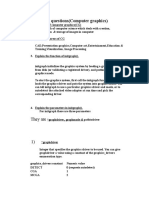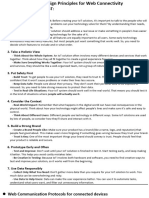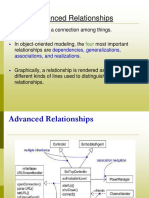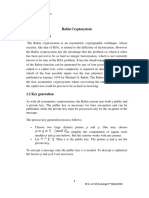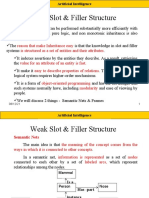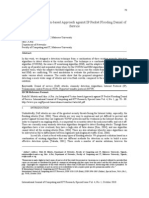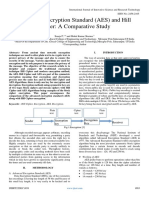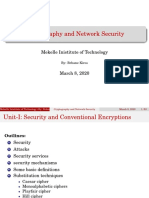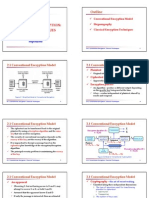Professional Documents
Culture Documents
Ooad Case Studies
Ooad Case Studies
Uploaded by
Thanuja Malla100%(4)100% found this document useful (4 votes)
2K views21 pagesooad material
Original Title
OOAD CASE STUDIES(1)
Copyright
© © All Rights Reserved
Available Formats
DOCX, PDF, TXT or read online from Scribd
Share this document
Did you find this document useful?
Is this content inappropriate?
Report this Documentooad material
Copyright:
© All Rights Reserved
Available Formats
Download as DOCX, PDF, TXT or read online from Scribd
Download as docx, pdf, or txt
100%(4)100% found this document useful (4 votes)
2K views21 pagesOoad Case Studies
Ooad Case Studies
Uploaded by
Thanuja Mallaooad material
Copyright:
© All Rights Reserved
Available Formats
Download as DOCX, PDF, TXT or read online from Scribd
Download as docx, pdf, or txt
You are on page 1of 21
OOAD CASE STUDIES FROM UNIT 1 TO UNIT 5
1. Case Study: System Architecture: Satellite-Based
Navigation:
Here, WE approach the development of the system architecture for
the hypothetical SatelliteNavigation System (SNS) by logically
partitioning the required functionality.
Requirements for the Satellite Navigation System
Vision:
Provide effective and affordable Satellite Navigation System
services for our customers.Functional requirements:
Provide SNS services
Operate the SNS
Maintain the SNS
Nonfunctional requirements:
Level of reliability to ensure adequate service guarantees
Sufficient accuracy to support current and future user needs
Functional redundancy in critical system capabilities
Extensive automation to minimize operational costs
Easily maintained to minimize maintenance costs
Extensible to support enhancement of system functionality
Long service life, especially for space-based elements
Defining the Boundaries of the Problem
2. Case Study: Control System: Traffic Management
The document describes a traffic management system with the following
key elements: Sensors detect traffic density and report it to a central
control room. The control room sends signal times to coordinate traffic
flow. In emergencies, sensors notify the control room which contacts
local hospitals. Alternative routes are displayed on message boards.
Speeding vehicles are reported to downstream police. Traffic data is
logged to analyze road usage.
Mission Statement:
Government wishes to automate traffic management system: there are sensors
at each traffic signal. Each sensor senses the traffic densityand reports
it to central control room. The control room sends signals (green signal
and waiting time). All the signals follow a pattern for
ON and OFF like when one signal is GREEN then opposite direction signalis
RED and vice versa.
In case of accident, sensor sends signal to the control room, traffic at that time is
regulated accordingly. Nearest hospital is contacted and is asked to
report immediately. In case of rally and processions and road maintenance,
alternative ways/roads are flashed on the Flash Boards. During normal
conditions boards display traffic status of nearby areas where the
corresponding road leads. In case someone breaks the signal or exceeds
speed limit vehicle number and the direction in which it is going is noted.
The
trafficpolicea t t h e n e x t c o r r e s p o n d i n g s i g n a l a r e i n f o
r m e d a b o u t i t s o t h a t appropriate action can be taken.
3. Case Study: AI: Cryptanalysis:
4. Thanks to the profusion of cybercriminals, cybersecurity professionals must
have an extensive toolbox filled with everything needed to keep data,
networks, and systems safe. But unfortunately, some of those same tools can
be used by cybercriminals to wreak havoc on systems and commit
cybercrimes.
5. But no matter which side of the law anyone falls on, it's true that there's a
dizzying number of tools, techniques, and resources available
in cybersecurity. So in our ongoing effort to inform and demystify these tools,
we focus today on cryptanalysis.
6. This article defines cryptanalysis, identifies its users, and explores
cryptanalysis attacks and techniques. We will also look at some cryptanalysis
tools and the different forms of cryptanalysis.
7. Let’s kick things off with the question, “What is cryptanalysis?”
8. What Is Cryptanalysis?
9. Cryptanalysis is the study and process of analyzing and decrypting ciphers, codes, and
encrypted text without using the real key. Alternately, we can say it’s the technique of
accessing a communication’s plain text content when you don’t have access to the
decryption key.
10. Put simply, cryptanalysis is the practice, science, or art of decrypting encrypted
messages.
11. Cryptanalysis experts study ciphers, cryptosystems, and ciphertext to understand their
functions. Then, they use that knowledge to find or improve techniques to weaken or
defeat them. However, as we're about to see, it can be used for good or nefarious
purposes.
12. So, a cryptographer is someone who writes encryption code used in cybersecurity,
while a cryptoanalyst is someone who tries to crack those encryption codes. Two
opposing sides of the cybersecurity coin, locked in conflict, trying to one-up the other,
constantly inventing new measures and countermeasures. This rivalry drives the
innovation found in the cybersecurity field.
13. Web Application: Vacation Tracking System
14. Case Study: Weather Forecasting:
Weather Forecasting Application is one of the most common mini
project in Software Development .
we are going to make a Weather Forecasting Application from
scratch which will tell us the weather of any location using its name .
Weather forecasting is a challenging area. To protect life and property weather
warnings is important forecast.
You might also like
- UML Diagrams Example-Weather Monitoring SystemDocument15 pagesUML Diagrams Example-Weather Monitoring SystemS.Arul Patchi Prasath97% (86)
- OOAD Unit 5 - Traffic Management SystemDocument20 pagesOOAD Unit 5 - Traffic Management Systemlilooooooooooo100% (4)
- Unit-5 CCDocument22 pagesUnit-5 CCSonga Sowjanya80% (5)
- Cloud Computing NotesDocument35 pagesCloud Computing NotesFeisal MohamedNoch keine Bewertungen
- CG Viva+questions+&ANSWERSDocument13 pagesCG Viva+questions+&ANSWERSJinsKJoy75% (4)
- Information Security Principles and Practice Mark StampDocument9 pagesInformation Security Principles and Practice Mark StampalpanatewariNoch keine Bewertungen
- 3-1 Policies and MechanismsDocument2 pages3-1 Policies and MechanismsJathin DarsiNoch keine Bewertungen
- System Architecture: Satellite-Based NavigationDocument7 pagesSystem Architecture: Satellite-Based NavigationJagannathan Mj100% (9)
- Summer Internship ReportDocument12 pagesSummer Internship ReportchanchalNoch keine Bewertungen
- 1.1. Purpose: Software Requirements Specification For Blind Voice MailDocument15 pages1.1. Purpose: Software Requirements Specification For Blind Voice MailDinesh Choudhary50% (2)
- A Cryptographic CompendiumDocument832 pagesA Cryptographic Compendiumadilullo100% (4)
- Unit-2-Symmetric Key Techniques (Part-1)Document80 pagesUnit-2-Symmetric Key Techniques (Part-1)Komal ChaudharyNoch keine Bewertungen
- Unit-Iv: 4.1 System Architecture: Satellite-Based NavigationDocument27 pagesUnit-Iv: 4.1 System Architecture: Satellite-Based NavigationAli Jama100% (1)
- Traffic Management SystemDocument9 pagesTraffic Management SystemNareshNoch keine Bewertungen
- OOAD Unit 5 - Traffic Management SystemDocument20 pagesOOAD Unit 5 - Traffic Management SystemSowmya SNoch keine Bewertungen
- Viden Io SRM University Notes Fourth Semester Vacation Tracking SystemDocument20 pagesViden Io SRM University Notes Fourth Semester Vacation Tracking SystemJagannathan MjNoch keine Bewertungen
- Case Study On Traffic Management SystemDocument35 pagesCase Study On Traffic Management SystemSuraj Brijwani67% (6)
- ch-11 Interfaces, Types and RolesDocument14 pagesch-11 Interfaces, Types and Rolesbhargavi0% (1)
- 2 Organized and Disorganized ComplexityDocument9 pages2 Organized and Disorganized ComplexityDurgavajjala KarthikNoch keine Bewertungen
- Bản sao của Web+Application-+Vacation+TrackingDocument3 pagesBản sao của Web+Application-+Vacation+TrackingTrần Phan Quang ĐứcNoch keine Bewertungen
- Lifecycle Expectations - Software Project ManagementDocument2 pagesLifecycle Expectations - Software Project ManagementRiyaz Shaik50% (2)
- Day 4 Five Attributes of A Complex SystemDocument10 pagesDay 4 Five Attributes of A Complex SystemPuneeth nallandula100% (1)
- UNIT3Document63 pagesUNIT3orangesareamazing46Noch keine Bewertungen
- ST Module - 5Document53 pagesST Module - 5Dbit DocsNoch keine Bewertungen
- State Testing, and Testability Tips. Power of A Matrix, Node Reduction AlgorithmDocument13 pagesState Testing, and Testability Tips. Power of A Matrix, Node Reduction AlgorithmSeerapu RameshNoch keine Bewertungen
- UNIT-3 Design Principles For Web Connectivity (RGPV 2023 Special)Document19 pagesUNIT-3 Design Principles For Web Connectivity (RGPV 2023 Special)anujsonib1999Noch keine Bewertungen
- CHAPTER - 4 Transaction Flow TestingDocument3 pagesCHAPTER - 4 Transaction Flow TestingDIWAKAR U100% (1)
- Data Acquisition - Weather Monitoring SystemDocument4 pagesData Acquisition - Weather Monitoring SystemHalamathi HabiboNoch keine Bewertungen
- Design of Lexical Analyzer GeneratorDocument14 pagesDesign of Lexical Analyzer GeneratorAarthiNoch keine Bewertungen
- OOAD Unit Wise Imp QuestionsDocument2 pagesOOAD Unit Wise Imp QuestionsbalakailasaNoch keine Bewertungen
- Viva QuestionsDocument37 pagesViva QuestionsBrynal Correia100% (1)
- Online Search AgentsDocument13 pagesOnline Search AgentsHari Deivasigamani100% (1)
- UNIT-4B-Logic Based TestingDocument38 pagesUNIT-4B-Logic Based TestingAparna GattimiNoch keine Bewertungen
- Department of Information Science and Engineering 18IS62-Software Testing NotesDocument36 pagesDepartment of Information Science and Engineering 18IS62-Software Testing NotesAkhila R100% (5)
- Compiler Design Unit 2Document117 pagesCompiler Design Unit 2Arunkumar PanneerselvamNoch keine Bewertungen
- Software Engineering Viva QuestionsDocument11 pagesSoftware Engineering Viva QuestionsPREETAM SOW MONDAL0% (1)
- Cse-Viii-Software Testing (10CS842) - Question Paper PDFDocument5 pagesCse-Viii-Software Testing (10CS842) - Question Paper PDFRanjeetSinghNoch keine Bewertungen
- Specialized Process Models: Muhammad NomanDocument20 pagesSpecialized Process Models: Muhammad NomanMohammad NomanNoch keine Bewertungen
- CS6551 Computer Networks Two Mark With AnswerDocument35 pagesCS6551 Computer Networks Two Mark With AnswerPRIYA RAJI100% (7)
- 2.9 Reasoning Systems For Categories, Reasoning With Default InformationDocument12 pages2.9 Reasoning Systems For Categories, Reasoning With Default InformationAnime Geeker100% (1)
- Horizontal Prototype Vertical Prototype Analysis Prototype Domain PrototypeDocument1 pageHorizontal Prototype Vertical Prototype Analysis Prototype Domain PrototypeGangaa ShelviNoch keine Bewertungen
- Traffic Prediction Using MLDocument7 pagesTraffic Prediction Using MLRavi Shankar0% (1)
- Structure and Examples of Complex SystemsDocument32 pagesStructure and Examples of Complex SystemssufyanasifNoch keine Bewertungen
- ch-10 Advanced RelationshipsDocument33 pagesch-10 Advanced RelationshipsbhargaviNoch keine Bewertungen
- Strong Slot & Filler Structure Cha 10Document13 pagesStrong Slot & Filler Structure Cha 10Nitesh Mishra92% (12)
- Third Year Sixth Semester CS6601 Distributed System 2 Mark With AnswerDocument25 pagesThird Year Sixth Semester CS6601 Distributed System 2 Mark With AnswerPRIYA RAJI86% (7)
- CG Viva Questions ANSWERSDocument13 pagesCG Viva Questions ANSWERSrajeshmanam0% (1)
- JNTUK R20 ML UNIT-I FinalDocument22 pagesJNTUK R20 ML UNIT-I Finalsanjanareddy.satti24Noch keine Bewertungen
- 8-Benefits and Risks of Object Oriented Development-16-Dec-2019Material - I - 16-Dec-2019 - 7 - The - Benefits - of - Object-Oriented - DevelopmentDocument7 pages8-Benefits and Risks of Object Oriented Development-16-Dec-2019Material - I - 16-Dec-2019 - 7 - The - Benefits - of - Object-Oriented - DevelopmentAkshat Gupta100% (1)
- KTU S7 Elective: CST433 Security in ComputingDocument8 pagesKTU S7 Elective: CST433 Security in ComputingJishnu ManikkothNoch keine Bewertungen
- Software Testing Viva Questions and Answer Mca Sem5Document11 pagesSoftware Testing Viva Questions and Answer Mca Sem5Unknown100% (5)
- Cse Viii Software Testing (10cs842) SolutionDocument39 pagesCse Viii Software Testing (10cs842) SolutionRanjeetSingh71% (7)
- Difference Between Sequence and CollaborationDocument2 pagesDifference Between Sequence and CollaborationGaurav Pattnaik0% (1)
- Informal Design Guidelines For Relation SchemasDocument19 pagesInformal Design Guidelines For Relation SchemasadddataNoch keine Bewertungen
- Rabin Cryptosystem 1.1 IntroductionDocument8 pagesRabin Cryptosystem 1.1 IntroductionBillal HossainNoch keine Bewertungen
- Weak Slot & Filler Structure Chap 9Document17 pagesWeak Slot & Filler Structure Chap 9Nitesh Mishra83% (18)
- Message Integrity and AuthenticationDocument41 pagesMessage Integrity and AuthenticationRAJ TAPASENoch keine Bewertungen
- Taxonomy of BugsDocument8 pagesTaxonomy of BugsVikas Maurya100% (1)
- Internship (1) FinalDocument12 pagesInternship (1) FinalManak Jain50% (4)
- 655dc150d84d8 Dataverse Round 2Document10 pages655dc150d84d8 Dataverse Round 2Shantanu BharvirkarNoch keine Bewertungen
- A Proposed Architecture For Network Forensic System in Large-Scale NetworksDocument14 pagesA Proposed Architecture For Network Forensic System in Large-Scale NetworksAIRCC - IJCNCNoch keine Bewertungen
- An Integrated Victim-Based Approach Against IP Packet Flooding Denial of ServiceDocument11 pagesAn Integrated Victim-Based Approach Against IP Packet Flooding Denial of ServicepalashvermaNoch keine Bewertungen
- 368Document4 pages368isabelline3Noch keine Bewertungen
- Cryptography and Network Security - Module - 1Document51 pagesCryptography and Network Security - Module - 1srujana hulkoduNoch keine Bewertungen
- Introduction To SecurityDocument95 pagesIntroduction To SecurityDhamodaran SrinivasanNoch keine Bewertungen
- Advanced Encryption Standard (AES) and Hill Cipher A Comparative StudyDocument3 pagesAdvanced Encryption Standard (AES) and Hill Cipher A Comparative StudyInternational Journal of Innovative Science and Research TechnologyNoch keine Bewertungen
- Cryptography, Network Security and Cyber Laws Notes 2019-2020Document23 pagesCryptography, Network Security and Cyber Laws Notes 2019-2020Himanshu KumarNoch keine Bewertungen
- Cryptography Chapter 1 For ECEDocument60 pagesCryptography Chapter 1 For ECEambachew tekaNoch keine Bewertungen
- Plaintext - CiphertextDocument31 pagesPlaintext - CiphertextRAJ TAPASENoch keine Bewertungen
- Domain 3 QuestionsDocument16 pagesDomain 3 QuestionsRajaram K.VNoch keine Bewertungen
- Itt ProjectDocument40 pagesItt Projectdeepti ranjan sahooNoch keine Bewertungen
- Jshara Icsns Viii CryptomlDocument10 pagesJshara Icsns Viii CryptomlBahr SimoNoch keine Bewertungen
- Baumslag G. A Course in Mathematical Cryptography 2015Document598 pagesBaumslag G. A Course in Mathematical Cryptography 2015Ovidiu TomaNoch keine Bewertungen
- Conventional EncryptionDocument15 pagesConventional EncryptionShashank MohanNoch keine Bewertungen
- CS304 Scribe Week1Document4 pagesCS304 Scribe Week1Sanskar PatelNoch keine Bewertungen
- Encoded Communications of World War IIDocument3 pagesEncoded Communications of World War IIMirza ShahrezaNoch keine Bewertungen
- Police Intelligence (Lea 24)Document179 pagesPolice Intelligence (Lea 24)Shela Lapeña Escalona100% (3)
- Cyber Security Internship ReportDocument26 pagesCyber Security Internship ReportSARATH CHANDRANoch keine Bewertungen
- Algebraic AnalysisDocument17 pagesAlgebraic AnalysisibrahimNoch keine Bewertungen
- Cryptography Notes-5-23Document19 pagesCryptography Notes-5-23Harmeet KaurNoch keine Bewertungen
- Sy0-701 - Lesson 03Document34 pagesSy0-701 - Lesson 03kairaandkamsiNoch keine Bewertungen
- DNA Encoding and Channel Shuffling For Secured Encryption of Audio DataDocument24 pagesDNA Encoding and Channel Shuffling For Secured Encryption of Audio DataAman Kumar TrivediNoch keine Bewertungen
- Lesson 7Document42 pagesLesson 7Nithya NairNoch keine Bewertungen
- Message Authentication CodesDocument18 pagesMessage Authentication CodesNguyễn Hồng LêNoch keine Bewertungen
- SteganographytutorialDocument39 pagesSteganographytutorialSanjeev Kumar SinhaNoch keine Bewertungen
- Reviewer Kay Sir JedDocument12 pagesReviewer Kay Sir JedRic EstanislaoNoch keine Bewertungen
- NS by MU PDFDocument252 pagesNS by MU PDFakash mayekarNoch keine Bewertungen
- Vignere Cipher EtcDocument72 pagesVignere Cipher EtcAhsan JameelNoch keine Bewertungen
- CH 03Document124 pagesCH 03baidnirvana8Noch keine Bewertungen
- Code Breaker, Spy Hunter Teaching GuideDocument14 pagesCode Breaker, Spy Hunter Teaching GuideAbrams BooksNoch keine Bewertungen




